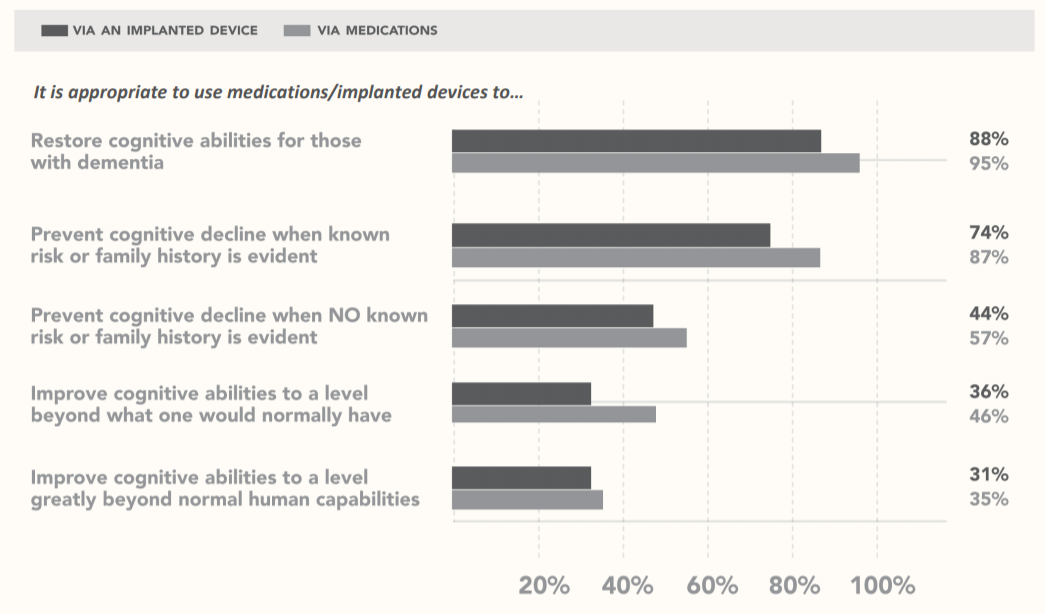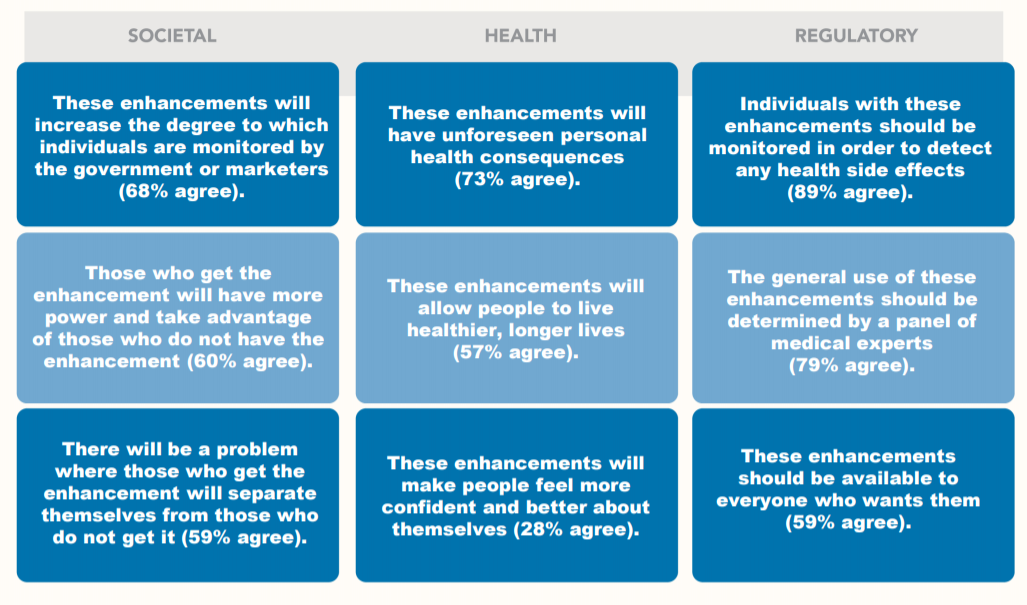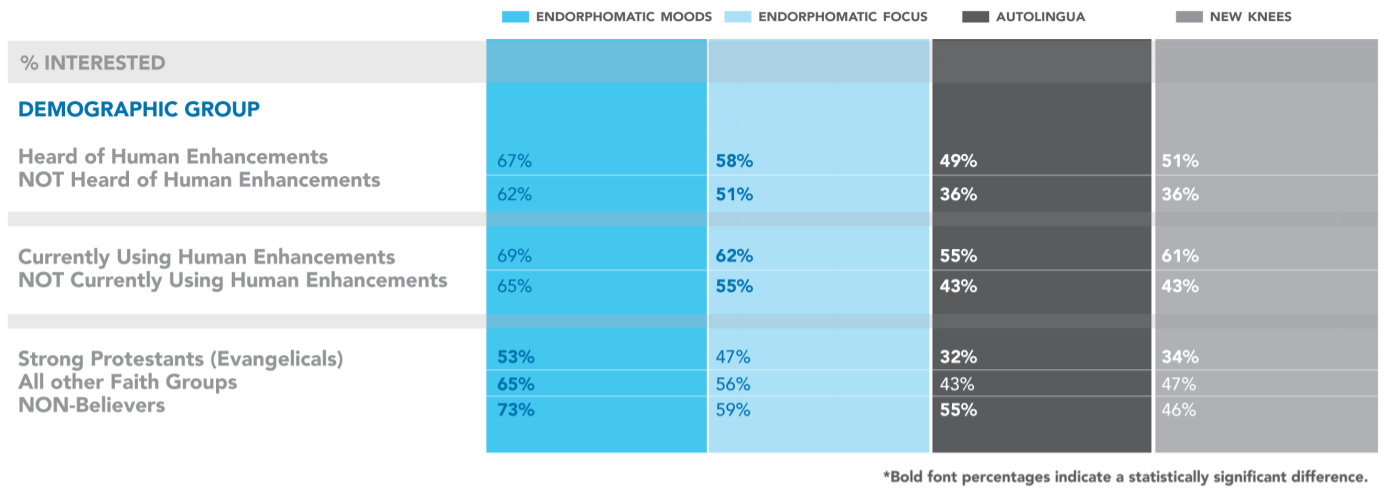Consumers Are Open to Superhuman Vision and Cognitive Enhancements. Are Regulators?
The first comprehensive survey on attitudes about human enhancement finds Americans are open to some crazy new technologies.

Body modifications that restore lost capabilities have existed since the invention of the prosthetic limb in the 11th century. But we are now several years into an era of technologies that do more than crudely mimic lost parts. The BiOM Ankle System, developed by double-amputee Hugh Herr at the Massachusetts Institute of Technology, is the first prosthetic to achieve "biomechanical and physiological normalization." Researchers at Johns Hopkins University, meanwhile, have developed a bone-integrated prosthetic arm that operates using the same nerve signals that controlled the original human limb. In 2016 the Food and Drug Administration approved the first closed-loop insulin delivery system that effectively mimics the function of the pancreas for type-1 diabetics. And just two months ago, the agency approved the first therapy that can replace the defective gene that causes a rare form of inherited blindness.
Yet a new survey released by the AARP finds that most Americans are unfamiliar with advances in human enhancement technology, and upon learning of them are supportive only up to a point. "Most people agreed that these technologies would help the people who used them even if they're scared of what it might to do to society as a whole," says Debra Whitman, executive vice president and chief public policy officer for the AARP.
The AARP commissioned NORC to survey 2,000 Americans in August and September of last year. Respondents were asked about five generic categories: vision enhancement, joint enhancement, cognitive enhancement via medication, cognitive enhancement via implant, and gene therapy. NORC also polled respondents on three imaginary technologies dreamed up by the Dubai Future Foundation: the Endorphomatic, a device applied to the forehead that measures hormone levels and uses those readings to "improve mood and enable relaxation"; Autolingua, a brain implant that allows users to understand five common languages; and New Knees, a joint replacement technology that would grant users superhuman running, jumping, and lifting abilities.
Only 25 percent of respondents knew "some" or "a lot" about enhancement technology, a finding that Whitman attributes partly to the communication gap between researchers and the general public, partly the definition. Only nine percent of respondents said they had used an existing enhancement technology, a definition that includes organ transplants, pacemakers, prosthetics, joint replacements, and medications. A more expansive definition that included, say, reading glasses, corrective eye surgery, platelet-rich plasma injections, and orthopedic shoe inserts would have found a substantially larger group. Then again, we don't tend to think of ubiquitous technologies as technology at all. On the long spectrum of human accomplishment, microwaves and televisions are closer to the Enterprise's holodeck than to the horse and buggy, but by now we treat them as relatively pedestrian.
Perhaps because of the definition, only a minority of respondents expressed personal interest in enhancing their own abilities. Medication-assisted cognitive enhancement was the most popular at 43 percent, followed by vision enhancement at 35 percent, implant-assisted cognitive enhancement at 34 percent, and joint enhancement at 25 percent. Support for each was highest in scenarios where the technology would restore lost abilities, with support declining as the perceived necessity declined. The below chart is for both types of cognitive enhancement, but the results for vision and joints look pretty much the same:

Concerns about enhancement revolved around socioeconomic access, surveillance, medical side effects, and social stratification by ability. Surprisingly, a majority of respondents agreed that these enhancements "should be available to everyone who wants them":

Eighty percent of respondents think "ethics professionals" should be involved in decisions about enhanced technologies, while only 37 percent said that religious leaders should play a role:

Support for the Dubai Future Foundation's concepts, meanwhile, skewed male, educated, and secular:


For the most part, support for enhancement was highest among people who are already familiar with, or using, existing enhancement technologies; who are male and under 50; and who identify as "non-believers." Basically, the Silicon Valley/nootropics/biohacking set. Protestant resistance to enhancement, which is consistent across the study, took me by surprise. I'd love to know whether the skepticism is socioeconomic (This will just make the rich richer) or theological (If God wanted me to have Go Go Gadget Arms, etc.); and also why followers of other religions are more sanguine about it.
While the generic cognitive enhancement survey question says that respondents are most worried about the "effects on society," the biggest two concerns expressed about Endorphomatic were unforeseen side effects (86 percent) and addiction (80 percent). That leads me to believe that as these technologies move from the realm of broad speculation to specific application, the concerns will be more immediate and visceral. When it came to New Knees, more people were worried about medical side effects than the effects on society, probably because it is easier to picture someone slicing open their knees and wacking at their connective tissue than it is to imagine how that procedure might change the world.
The least surprising aspect of the study was the overall support for drug-assisted cognitive enhancement. "When you look at the aging population, you see a lot of interest in cognition," Whitman tells me. "People want to know, 'How do we extend our health spans?'" The "health span" concept is exactly what it sounds like: the length of time for which we are not just alive, but healthy. With Alzheimer's and other forms of dementia hanging over the largest generation of elderly persons America has ever seen, we should expect boomer and (eventually) Gen X support for cognition-enhancing technologies to only increase.
But even support across the age spectrum won't necessarily pave the way for the most controversial category of enhancements—technologies that make us better than we are at our natural best. The hurdle for that category is purely philosophical, since we already have technologies that can produce supraphysiological results. Stimulants can help you focus better than you otherwise would; androgens can help you recover and gain muscle faster. But those and other drugs are regulated as therapies and are thus dispensable only for the treatment of specific diseases. And those two technologies aren't even all that new. How will regulators respond to the first prototype of a product like Autolingua? I can't imagine the Food and Drug Administration having nothing to say, but the agency also has no system for reviewing or approving medical technologies that don't serve a diagnostic or therapeutic purpose.
Whether the concept tech envisioned by the Dubai Future Foundation is five years from possible or 50, it feels more immediate than a U.S. regulatory body that won't try to strangle it in the crib.
Want to see more of the bionic man? Check out Freethink Media's documentary about Johnny Matheny, the test subject for the world's most advanced bionic prosthesis:


Show Comments (86)